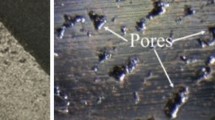Abstract
This paper reports some recent results related to active monitoring of powder bed fusion (PBF-LB) processes through analysis of layer-by-layer surface profile data. Estimation of fault probability was carried out experimentally in a Renishaw AM250 machine, by collecting Fe3Si powder bed height data, in situ, during the metal additive manufacturing of a heat exchanger section, comprised a series of conformal channels. Specifically, high-resolution powder bed surface height data from a laser profilometer was linked to post-print ground-truth labels (faulty or nominal) for each site from computed tomography (CT) scans, by training a shallow artificial neural net (ANN). The ANN demonstrated interesting capabilities for discovering correlations between surface roughness characteristics and the presence and size of faults. Strong performance was achieved with respect to several standard metrics for classifying faulty and nominal sites. These developments can potentially enable active monitoring processes to become a future component of a layer-by-layer feedback system for better control of PBF-LB processes.


















Similar content being viewed by others
Availability of data and material
Not available due to IP restrictions.
Code availability
Not available due to IP restrictions.
References
Gibson I, Rosen D, Stucker B (2014) Additive manufacturing technologies: 3d printing, rapid prototyping, and direct digital manufacturing, 2nd edn. Springer
Chern AH et al (2019) A review on the fatigue behavior of Ti-6Al-4V fabricated by electron beam melting additive manufacturing. Int J Fatigue 119:173–184. https://doi.org/10.1016/j.ijfatigue.2018.09.022
Lee YS, Zhang W (2016) Modeling of heat transfer, fluid flow and solidification microstructure of nickel-base superalloy fabricated by laser powder bed fusion. Addit Manuf 12:178–188. https://doi.org/10.1016/j.addma.2016.05.003
Plotkowski A, Kirka MM, Babu SS (2017) Verification and validation of a rapid heat transfer calculation methodology for transient melt pool solidification conditions in powder bed metal additive manufacturing. Addit Manuf 18:256–268. https://doi.org/10.1016/j.addma.2017.10.017
Purtonen T, Kalliosaari A, Salminen A (2014) Monitoring and adaptive control of laser processes. Phys Procedia 56:1218–1231. https://doi.org/10.1016/j.phpro.2014.08.038
Tapia G, Elwany A (2014) A review on process monitoring and control in metal-based additive manufacturing. J Manuf Sci Eng 136(6):060801–10. https://doi.org/10.1115/1.4028540
Abdelrahman M, Reutzel EW, Nassar AR, Starr TL (2017) Flaw detection in powder bed fusion using optical imaging. Addit Manuf 15:1–11. https://doi.org/10.1016/j.addma.2017.02.001
Gobert C, Reutzel EW, Petrich J, Nassar AR, Phoha S (2018) Application of supervised machine learning for defect detection during metallic powder bed fusion additive manufacturing using high resolution imaging. Addit Manuf 21:517–528. https://doi.org/10.1016/j.addma.2018.04.005
Scime L, Beuth J (2018) Anomaly detection and classification in a laser powder bed additive manufacturing process using a trained computer vision algorithm. Addit Manuf 19:114–126. https://doi.org/10.1016/j.addma.2017.11.009
Scime L, Beuth J (2019) Using machine learning to identify in-situ melt pool signatures indicative of flaw formation in a laser powder bed fusion additive manufacturing process. Addit Manuf 25:151–165. https://doi.org/10.1016/j.addma.2018.11.010
Tan Phuc L, Seita M (2019) A high-resolution and large field-of-view scanner for in-line characterization of powder bed defects during additive manufacturing. Mat Des 164:107562. https://doi.org/10.1016/j.matdes.2018.107562
Burger W, Burge MJ (2009) Principles of Digital Image Processing: Fundamental Techniques, 1 ed. (Undergraduate Topics in Computer Science). Springer-Verlag London
Clijsters S, Craeghs T, Buls S, Kempen K, Kruth JP (2014) In situ quality control of the selective laser melting process using a high-speed, real-time melt pool monitoring system. Int J Adv Manuf Technol 75:1089–1101. https://doi.org/10.1007/s00170-014-6214-8
Affine transformation: linear mapping method using affine transformation. MathWorks. https://www.mathworks.com/discovery/affine-transformation.html
Duda RO, Hart PE, Stork DG (2000) Pattern classification, 2nd edn. John Wiley & Sons, New York
Scime L, Beuth J (2019) Melt pool geometry and morphology variability for the Inconel 718 alloy in a laser powder bed fusion additive manufacturing process. Addit Manuf 29:100830. https://doi.org/10.1016/j.addma.2019.100830
Terry B (2020) Application of artificial neural nets to a selective laser sintering additive manufacturing process for fault detection
Renishaw — making dentistry digital. Additive Manufacturing.com. http://additivemanufacturing.com/2017/09/21/renishaw-making-dentistry-digital/
Baucher B, Chaudhary AB, Babu SS, Chakraborty S (2019) Defect characterization through automated laser track trace identification in SLM processes using laser profilometer data. J Mat Eng Perf 28(2):717–727. https://doi.org/10.1007/s11665-018-3842-4
Burger W, Burge MJ (2009) Principles of digital image processing: core algorithms. 1 ed. (Undergraduate Topics in Computer Science). Springer-Verlag London
myVGL: the free viewer app for your 3D data. Volume Graphics. https://www.volumegraphics.com/en/products/myvgl.html
Shapiro LG (1996) Connected component labeling and adjacency graph construction. IEEE Trans Pattern Anal Mach 19:1–30
Everton SK, Hirsch M, Stravroulakis P, Leach RK, Clare AT (2016) Review of in-situ process monitoring and in-situ metrology for metal additive manufacturing. Mat Des 95:431–445. https://doi.org/10.1016/j.matdes.2016.01.099
Ting KM (2010) Precision and recall. In: Sammut C, Webb GI (eds) Encyclopedia of Machine Learning. Springer, US, Boston, MA, pp 781–781
Powers D (2008) Evaluation: from precision, recall and F-factor to ROC, informedness, markedness & correlation
Koehrsen W Beyond accuracy: precision and recall, Towards Data Science. [Online]. Available: https://towardsdatascience.com/beyond-accuracy-precision-and-recall-3da06bea9f6c
Gobert CP, Phoha J, Nassar S, Abdalla R, Reutzel EW (2017) Machine learning for defect detection for PBFAM using high resolution layerwise imaging coupled with post-build CT scans. In: Presented at the Solid Freeform Fabrication Symposium. Austin, TX
Funding
This work was funded by the NAVAIR SBIR Program Office.
Author information
Authors and Affiliations
Corresponding author
Ethics declarations
Conflict of interest
The authors declare no competing interests.
Additional information
Publisher's Note
Springer Nature remains neutral with regard to jurisdictional claims in published maps and institutional affiliations.
Rights and permissions
About this article
Cite this article
Terry, B.S., Baucher, B., Chaudhary, A.B. et al. Active monitoring of powder bed fusion process by training an artificial neural net classifier on layer-by-layer surface laser profilometry data. Int J Adv Manuf Technol 119, 7765–7786 (2022). https://doi.org/10.1007/s00170-022-08722-2
Received:
Accepted:
Published:
Issue Date:
DOI: https://doi.org/10.1007/s00170-022-08722-2




